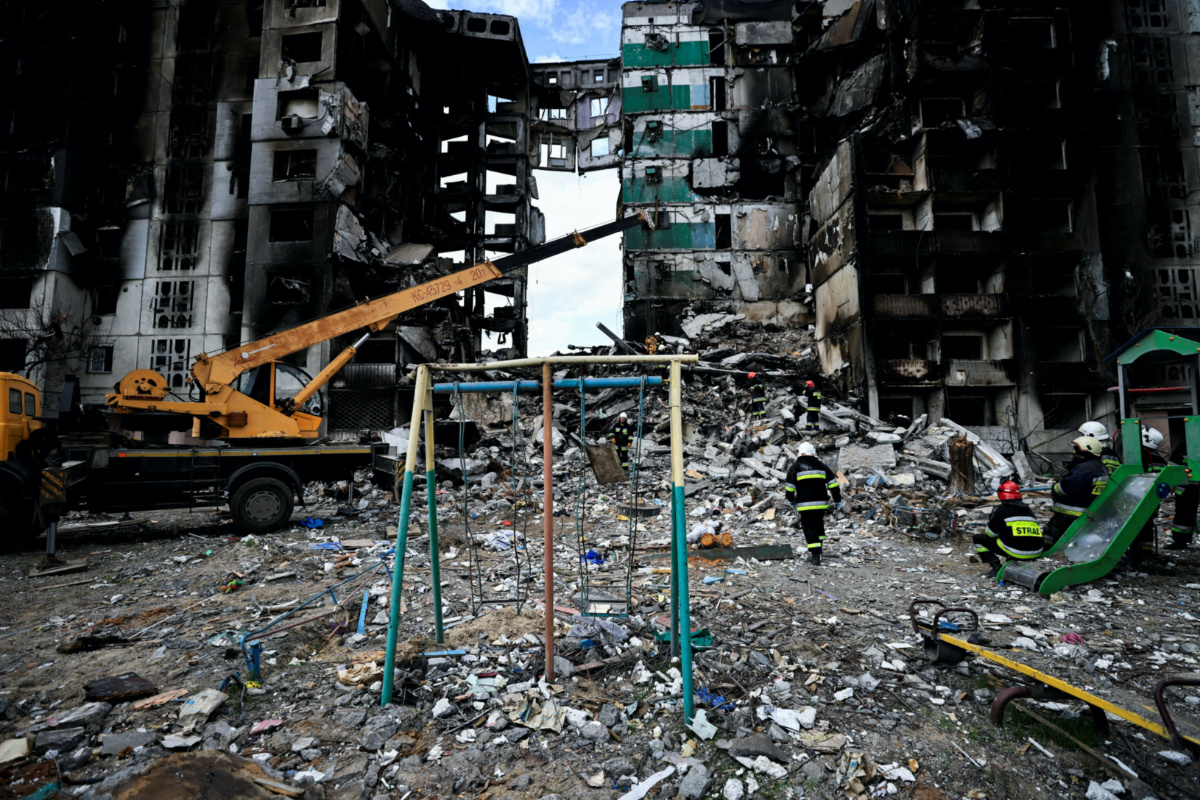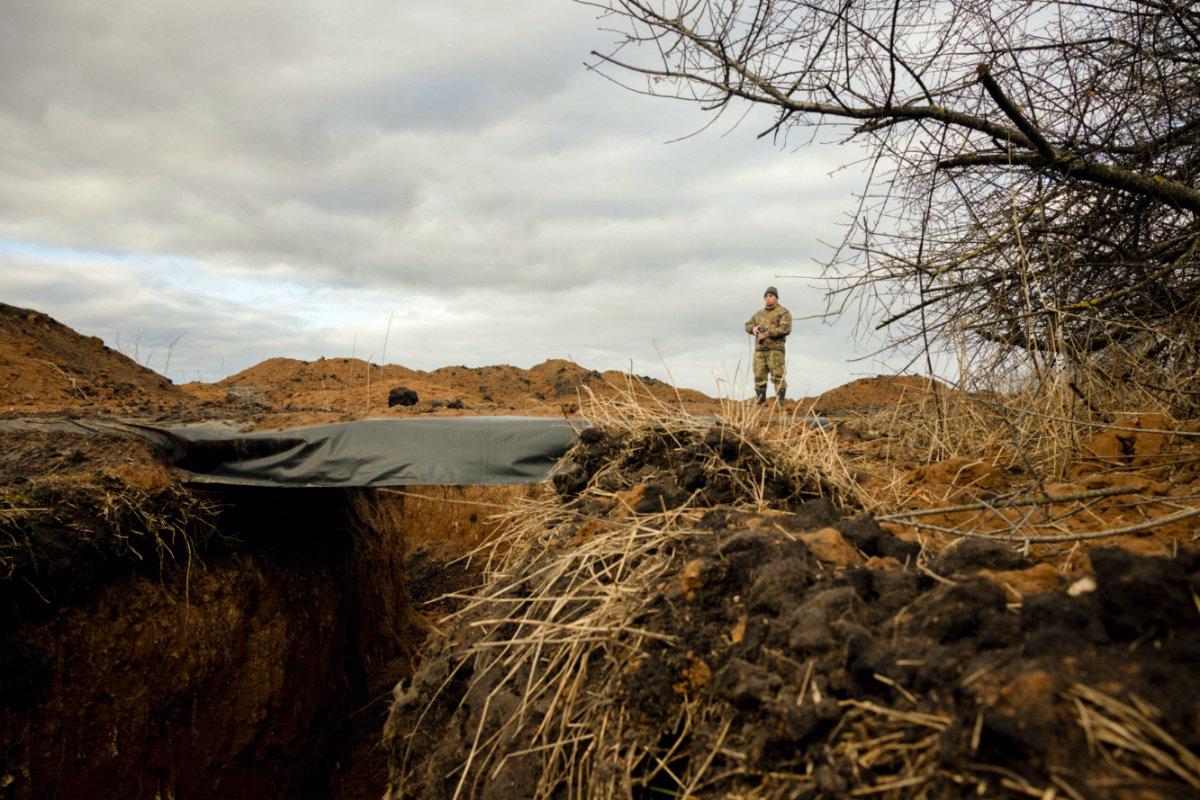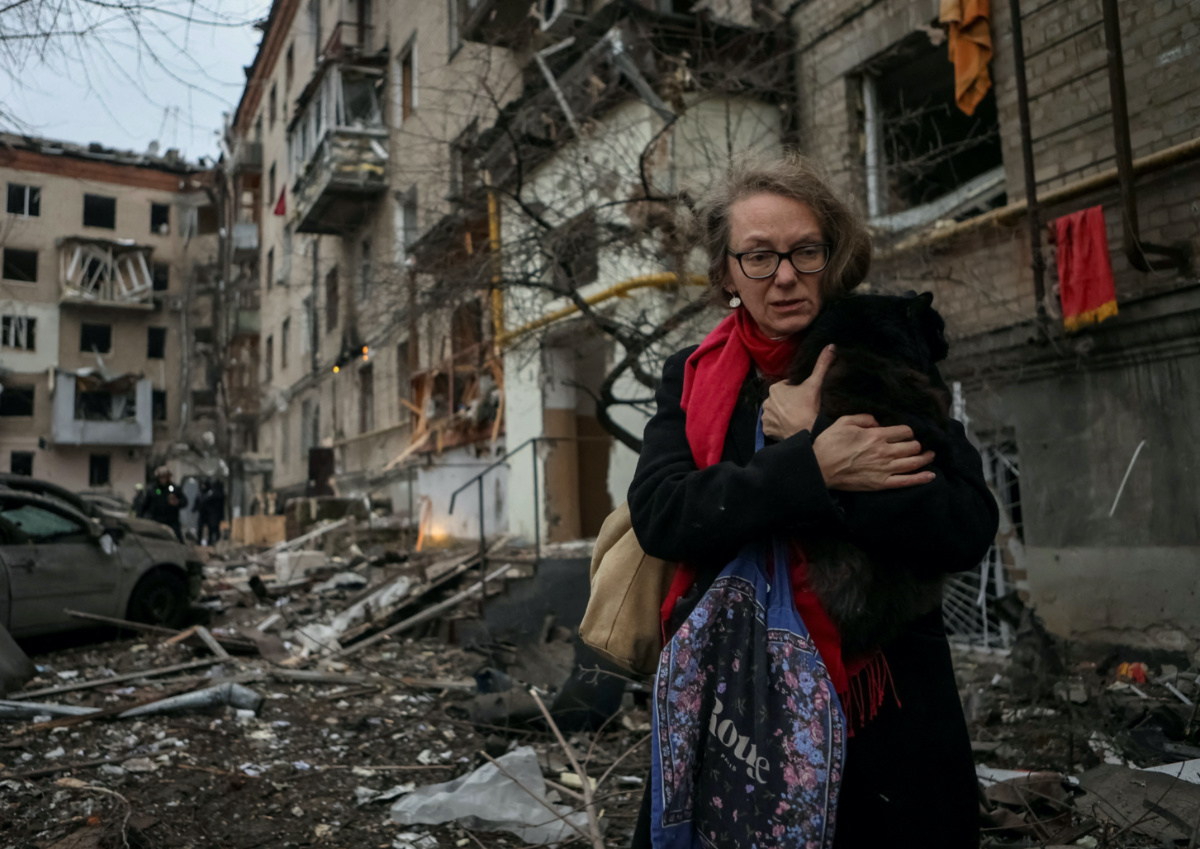
JON RICHARDSON, a visiting fellow at the Centre for European Studies at Australian National University, looks – in an article first published on The Conversation – at the devastation two years of war has wrought on Ukraine…
As its two-year anniversary approaches, Russia’s full-scale invasion of Ukraine has been pushed into the background of public attention by the war in Gaza.
The intense focus on Gaza has prompted comparisons between the two conflicts that tend to obscure or minimise the scale of destruction in Ukraine. “Ukraine fatigue” has also deepened around the world, as the fighting drags on along relatively static front lines.

A rescuer walks during a search operation for bodies under the rubble of a building destroyed by Russian shelling, amid Russia’s invasion of Ukraine, in Borodyanka, Kyiv region, Ukraine, on 11th April, 2022. PICTURE: Reuters/Zohra Bensemra/File photo
This is why, on the anniversary of the invasion, it’s important to take stock of the damage done to Ukraine and its people over the past two years. To do this, I’ve drawn on extensive reports from United Nations agencies, non-governmental organisations and international, Ukrainian and Russian media.
The overall scale of the destruction, as well as the repression of Ukrainian people and erasure of Ukrainian identity in territories annexed by Russia, lend support to the accusations that Russia has committed acts of genocide. It’s vital the world not forget this.
“The overall scale of the destruction, as well as the repression of Ukrainian people and erasure of Ukrainian identity in territories annexed by Russia, lend support to the accusations that Russia has committed acts of genocide. It’s vital the world not forget this.”
Civilian deaths in the tens of thousands
The Palestinian death toll in Gaza has been widely reported since the war began – it currently stands at more than 28,000. The civilian death toll in Ukraine is far less certain, or discussed.
As of the end of November, the United Nations had verified the deaths of at least 10,000 civilians in Ukraine.
However, this is likely to be a gross underestimate, “just the tip of the iceberg”, according to the UN High Commissioner for Human Rights. This is because Russia has blocked UN efforts to investigate in the Russian-controlled areas of southern and eastern Ukraine where most civilian deaths have likely occurred.
The most notorious case is Mariupol, once a city of 450,000, which suffered a devastating bombardment and blockade for almost three months in 2022. Estimates of civilian deaths there range from 22,000 to as high as 87,000.
Mystyslav Chernov, the Associated Press videographer whose documentary of the siege, 20 Days in Mariupol, has been nominated for an Academy Award, estimates between 70,000 and 80,000 people have likely died. Another AP reportprovides a similar estimate, based on interviews with workers documenting the collection of bodies from the streets.
Unlike Gazan authorities, the Ukrainian Government has been reluctant to make estimates of civilian deaths, perhaps for reasons of morale. Ukraine’s war crimes prosecutor did say in February, 2023, the total number of Ukrainian civilians killed could be higher than 100,000. Given the destruction in Mariupol and other cities, this seems plausible.
Half a million military casualties
Beyond the loss of civilian lives, one cannot ignore the needless waste of soldiers’ lives on both sides.
Neither Russia nor Ukraine has been forthcoming about their battlefield losses. US estimates last August put Russian soldier deaths at around 100,000 to 120,000 and Ukrainian soldier deaths at 70,000. The US estimated perhaps 500,000 total battlefield casualties (those killed and wounded) on both sides.
The UK Defence Ministry has provided figures in the same ballpark. This also tallies with a joint investigation by the BBC Russian service and independent Russian news site Mediazona, drawing on Russian media and social media. It estimated around 107,000 Russian soldier deaths and 321,000 wounded by late last year.
Most of the Ukrainian losses are young people who enlisted to defend their country from an unprovoked invasion. The stories of the dead have been recounted at length – medics, poets and other creatives, steelworkers, transport managers, students, beekeepers, to name a few.
About 60,000 women have also served in the armed forces, with more than 100 killed in action.
Among the casualties are amputees – perhaps as many as 50,000. By comparison, an estimated 41,000 Britons underwent amputations during the first world war.
International organisations report more than 6.5 million people have fled Ukraine since the war began, while 3.5 millionhave been displaced inside the country. This is about a quarter of the total pre-2022 population of 41 million.
In addition, about 17.6 million people are in need of humanitarian assistance, more than a quarter of whom are considered to be at a “catastrophic” level.

A Ukrainian soldier keeps watch at a freshly dug trench that his unit built as part of a system of new fortifications near the front lines outside Kupiansk, amid Russia’s attack on Ukraine, on 28th December, 2023. PICTURE: Reuters/Thomas Peter/File photo
Devastated national infrastructure
The destruction of Ukraine’s infrastructure from thousands of missile and drone attacks has been equally horrific. According to the World Bank and UN agencies, this includes:
• 10 per cent of Ukraine’s housing stock
• 8,400 kilometres of roads
• 13 per cent of Ukraine’s education infrastructure, including nearly 3,600 schools, kindergartens and universities
• more than 1,500 attacks on healthcare facilities
• nearly 4,800 sites in the cultural, heritage and tourism sector
• and extensive environmental devastation, such as the blowing up of the Kakhovka Dam, which flooded hundreds of square kilometres of land and caused some one million people to lose drinking water.
Ukraine’s economy shrank by 30 per cent in the first year of the war. The World Bank estimated this month the total cost of rebuilding the country at $US486 billion over 10 years, which is nearly three times Ukraine’s GDP in 2023.
Violent repression and coerced integration
Russia now occupies about 18 per cent of Ukraine’s territory – an area about the size of South Korea. It officially “annexed” four regions in late 2022, following Crimea’s annexation in 2014. Russia has since embarked on an ambitious program to change these regions’ ethnic composition, erase their Ukrainian identity and potential resistance, and integrate them into the Russian Federation.
As David Lewis of Exeter University explains, the Kremlin hopes to create a new reality on the ground that will be difficult to challenge in future. He reports an army of technocrats is overseeing a comprehensive absorption of the occupied territories, aligning their laws, regulations and tax and banking systems with Russia.
In another study of the Russification of occupied Ukraine, Karolina Hird notes locals are being coerced into getting Russian passports to obtain services such as health care. Similarly, occupation officials use the issuing of birth certificates, pensions, state payrolls and maternity payments to force residents to become reliant on the new government administrations.
We rely on our readers to fund Sight's work - become a financial supporter today!
For more information, head to our Subscriber's page.
The occupiers use violence to cement their control, as well. A special UN commission has documented killings, torture, sexual violence, arbitrary arrests, deportations and rapes.
The Danish Institute Against Torture documented at least 100 torture centres in prisons and police stations in south-eastern Ukraine. They employed such methods as electric shocks, beatings, suffocation, sleep deprivation, mock executions, threats and humiliation: “Our findings suggest that establishing torture chambers and torturing people in them was a routine practice in all places occupied by the Russian forces.”
The UN special rapporteur on torture also describes these Russian torture practices across Ukraine as “state war policy”.
In a recent case, human rights groups reported the torture and murder of Ukrainian priest Stepan Podolchak in the Kherson region on 13th February. Podolchak had held services in Ukrainian and was under pressure from the Russian security police to change his allegiance to the Russian Orthodox Church.
According to a BBC investigation, thousands of Ukrainians are being held on mostly spurious charges in prison colonies and detention centres inside Russia, with some disappearing or dying.
Mass deportations of children and cultural erasure
A year ago, the International Criminal Court issued arrest warrants for Russian President Vladimir Putin and Russia’s commissioner for children’s rights, Maria Lvova-Belova, in relation to the forced deportation of children from Ukraine to Russia. Russian officials had openly boasted of their role in the deportations, which they claimed were in the children’s interests.
Ukraine’s government has confirmed the deportations of more than 19,500 children. Some of the few children who have returned from Russia were told in school they would never leave Russia, that Ukraine didn’t exist and had never existed, and they were all really Russians.
As Latvia’s President, Edgars Rinkēvičs, put it recently: “Russia is actively erasing their Ukrainian identity and inflicting unbelievable emotional and psychological damage.”
Hundreds of thousands of Russian settlers have simultaneously moved to the occupied regions. Crimean Tatar leaders estimate between 850,000 and a million Russians have migrated to Crimea alone since 2014.
This is a direct violation of the Fourth Geneva Convention, which obliges an occupying power not to transfer parts of its own population into a territory it occupies.
The occupation regime is also erasing Ukrainian language and culture. This is consistent with Russian nationalist ideology portraying Ukrainian as a mere dialect of Russian and the Ukrainian nation as a fiction. Putin and others on Russian state television have constantly expounded these myths.
A Russian curriculum has been introduced in more than 900 schools in occupied regions, replacing previous instruction in Ukrainian in some. Hundreds of teachers are believed to have been relocated from Russia.

A local resident holding a cat leaves the site where residential buildings were heavily damaged during a Russian missile attack, amid Russia’s attack on Ukraine, in central Kharkiv, Ukraine, on 2nd January, 2024. PICTURE: Reuters/Sofiia Gatilova/File photo
Amnesty International reports that people risk reprisals for seeking to continue Ukrainian education. Some parents choose to hide their children to avoid them being taken to “re-education” institutions or for adoption in Russia.
At one school in Kherson, Amnesty reported, security officials ordered a mother to send her 15-year-old son back to school or “a bus will come next week and take [him] to an orphanage in Russia”. A school librarian said she secretly arranged meetings with students to give them Ukrainian books to avoid Russian patrols conducting arbitrary searches.
In addition, many Ukrainian streets and towns have been given new Russian names. For example, in Melitopol, a street named after a Ukrainian political theorist now bears the name of Pavel Sudoplatov, an infamous Stalinist secret agent who later boasted of organising Leon Trotsky’s assassination in Mexico.
To many observers, the erasure of Ukrainian nationhood in the occupied territories and frequent denial of Ukraine’s right to exist is evidence the Russian invasion is genocidal in nature. Some 30 genocide scholars, the Genocide Watchorganisation and several national parliaments have supported this assertion.
Whether or not the threshold of genocide has been reached, the invasion constitutes the most egregious land grab of a recognised state’s territory since the second world war, as I have argued elsewhere.
It remains a mystery why some people think the Ukrainians, or the international community, would or should accept this land and its people being traded away in negotiations at the point of a gun.![]()
Jon Richardson is a visiting fellow at the Centre for European Studies, Australian National University. This article is republished from The Conversation under a Creative Commons license. Read the original article.






